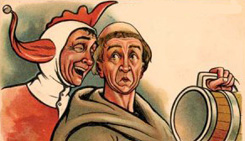 Asking questions should be a good thing. Jack Curtin comes up with some good ones.
Asking questions should be a good thing. Jack Curtin comes up with some good ones.
He asks: Can I say something about Randall the Enamel Animal that will piss a lot of people off? As the Dogfish website explains, Randall 3.0 is “a sophisticated filter system that allows the user to run draft beer through a chamber of whole leaf hops, spices, herbs, fruit, etc. so that the alcohol in the beer strips the flavor from what every you add and puts it in the beer.”
Curtin offers a different view, writing “It’s neat to play with and all that, but it has squat to do with brewing beer. Indeed, it is intended to supplant and override the flavor and nature of a beer that has been brewed.”
Wait. There’s more. “Gimmicks are fine for a passing moment, for a brief moment of fun, but they suck in the long run. Changing the nature of the beer which comes out of the kettle in the manner of its serving is demeaning to the whole process of brewing. It is the antithesis of what craft brewing was supposed to be all about.”
Gets you thinking doesn’t it? However, I can’t endorse a blanket condemnation of Randall & Associates any more than I favor mindless worship at the altar of change. After all, Dogfish founder Sam Calagione first rolled out Randall 1.0 to showcase his own beer. How is that different than a British brewer dry-hopping a cask?
Logically, you can draw a line between what amounts to a brewer extending what he does in the brewhouse and a publican mangling a brewer’s intentions by adding flavors at the bar. But aren’t “beer cocktails” all the rage? They blend not only beers from a single brewery, but cross the streams and even include other fermentables. Blurs the line. Makes it clear this is no simple question — all the more interesting to consider.
By that logic, I can’t blend two beers in my glass. Or that splash of port I threw in my coffee porter the other evening. I never appointed any brewer to that sort of sainthood. Smacks of putting the drinker in his or her place.
“How is that different than a British brewer dry-hopping a cask?”
Surely it is very different, because a British brewer dry hops the beer as part of the process. Straining a beer through a Randall is generally speaking not what a brewer has in mind when creating a beer. Sure Randall has its place, but that place is best served by beers created with its use in mind. I wonder what effect using a Randall with something like Bud Light would have?
Velky Al,
a) My point was that Dogfish invented Randall to serve its own beer. Jack is right that it was a gimmick from the beginning, but at least one that could be viewed as a logical extension of the brewing process.
b) Depends on the hops, obviously. I’ve heard of one experiment with Bud Light, Cascades and Randall. “Grassy, but dull, muted aroma and flavor. Perhaps because of the low alcohol content.” It took place in St. Louis, so the Bud Light should have been fresh ;>)
I would guess the difference between beer going through a Randall and a cask dry hop would be the consistency of the hop character throughout the keg if nothing else. First pour would be super hoppy as most of the oils go into the the first couple pints (usually which are poured out because it’s foamy). After that you’re not getting oils anymore, just the tannins and grassy characters.
I think it’s as valid or invalid as using a beer engine vs a regular tap to pour a beer. It changes the character of the beer for certain but whether that’s a good or bad thing is generally up to the consumer. Publicans have to offer some bonus items to make it worth the experience to drink craft beer in a bar for $6 – $10 a pour. I would think it odd if they served all of their IPAs through a Randall but having one on tap is a differentiation they can offer. If it truly sucks it won’t sell long (at least for craft beer folks – mass consumers may well let the ads tell them what to drink…)
At what point to the brewer have to let go and the beer is released into the market place, which is free to drink it as it sees fit. So many things affect the drinking experience, temperature, glassware, time on the shelf, temperature during storage, that the brewer simply can’t control. And as a beer drinker, may not necessarily want them to, either.
The Randall demonstrates hops effects on aroma and flavor in a easily understandable and visual way.
It would probably also be gimmicky to point blank refuse to drink one.
How do y’all feel about a slice of lemon served with your hefeweizen? Folks who don’t want the lemon really seem to *hate* the idea of lemon.
Stan, I did not check “Brewing With Wheat” to get your opinion . . . 🙂
Hey Craig – I collected input from several breweries and those who drink in Germany every day. I like what journalist Warren Obalski had to say: “Lemon with hefeweizen you only will see when Aussies and Kiwis drink it.”
Trinity Brewing in Colorado Springs uses a Randall theme. 0.25# of leaf hops/5 gal. A perfect use for some of our native hops to show off the hop. With quite a few different new hop flavors now but not a huge quantity,,,the Randaller theme has been a good thing for Trinity. Keeps life simple.